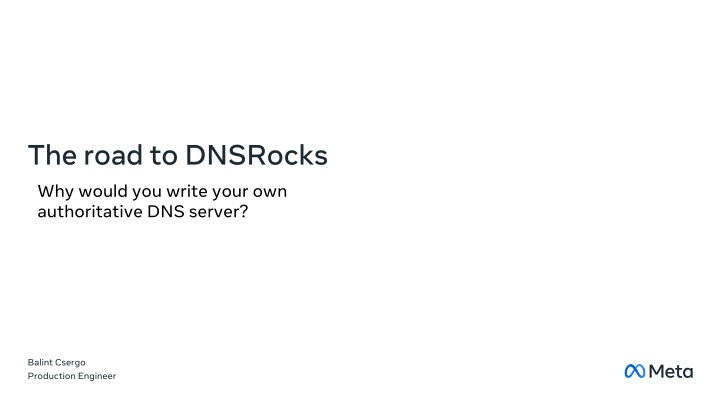
Building Your Own Authoritative DNS Server: A Journey to DNSRocks
"Discover the journey of developing an authoritative DNS server, from TinyDNS to DNSRocks with CDB backend and eventually RocksDB. Explore the reasons for creating your DNS server, the challenges faced, and the transition to open-source solutions. Uncover the history, features, and alternatives of TinyDNS along the way."
Download Presentation

Please find below an Image/Link to download the presentation.
The content on the website is provided AS IS for your information and personal use only. It may not be sold, licensed, or shared on other websites without obtaining consent from the author. If you encounter any issues during the download, it is possible that the publisher has removed the file from their server.
You are allowed to download the files provided on this website for personal or commercial use, subject to the condition that they are used lawfully. All files are the property of their respective owners.
The content on the website is provided AS IS for your information and personal use only. It may not be sold, licensed, or shared on other websites without obtaining consent from the author.
E N D
Presentation Transcript
The road to DNSRocks Why would you write your own authoritative DNS server? Balint Csergo Production Engineer
Agenda History TinyDNS DNSRocks with CDB backend DNSRocks with RocksDB DNSRocks OpenSource
01 History
01 History What do we need from a DNS server? Resolver IP based views EDNS Client Subnet views Simple to generate views Simple to configure Simple to deploy DB updates Query Logs Health metrics Latency requirements
DNS pipeline Config Repo HOST DB Network DB DNS Presenter DNS Publisher Zookeeper DNS MUTATOR Zookeeper Trackerless Torrent DNS HOST CORP Subscriber Automations dnsrocks Clients dnsrocks Unbound dnsrocks dnsrocks
01 History 2012 2018 2020 2022 TinyDNS DNSRocks with CDB backend DNSRocks with RocksDB Open Sourcing DnsRocks We start running our own implementation of an authoritative DNS server. We are still using a TinyDNS compatible format by default We have been using TinyDNS (with patches) We migrate from CDB to a RocksDB backend to support data growth Split off proprietary bits and provide useful Open source alternatives IPv6 support Switch to upstream dependencies where it made sense EDNS Client Subnet location matching Multiple Map support
02 TinyDNS
02 TinyDNS What was great about TinyDNS? Simple Efficient Very fast Line-based zone format Distributing data.cdb is simple
02 TinyDNS What was not so great about TinyDNS? Antiquated hard to read C code Not easy to extend Simplicity comes with trade-offs Lack of tests and modern programming paradigms Lot of global/static variables Hard for engineers to ramp up Single threaded
02 TinyDNS Open Source Alternatives Resolver View Supported ECS View Supported BIND Knot (Until 2.7.0) (Until 2.7.0) NSD PowerDNS (geoip backed) (geoip backed)
03 DNSRocks with CDB Backend
03 DNSRocks with CDB Backend Roll your own Go is a modern language miekg/dns is an amazing library, we ve built on top of that We reuse a lot of plumbing from CoreDNS Go tooling makes building/running/testing easy Good unit test coverage was a must Faster iteration speed Works with CDB, compatible with internal tooling Feature parity with TinyDNS, so rollout and A/B testing was simple A/B testing enabled us to profile our code, and optimize hotspots
04 DNSRocks with RocksDB
04 DNSRocks with RocksDB What s good about CDB speed: Data access is very very fast It s a constant database, it can be mmapped We know how to work with it already It s a very simple data structure, basically a hashmap
04 DNSRocks with RocksDB What s bad about CDB It s a constant database, we need to redeploy the whole view on every change, which causes constant recompilation, and increased propagation time This constant DB rewrite leads to SSD wear, we needed to store the DB in Ramdisk It s a 32 bit hashmap. 4 GB is the maximum size of a cdb database
04 DNSRocks with RocksDB RocksDB speed: RocksDB being mutable means we don t recompile anything. Incremental updates are possible and applying changes takes milliseconds. SSD wear: RocksDB is flash-ready, which meant we ve been be able to move back to SSDs and free up some precious RAM 32-bit limitations of CDB no longer apply, shards can get as big as we need. 4 GB isn t enough for everybody :)
04 DNSRocks with RocksDB RocksDB The steps we took: Writing CGO wrapper around RocksDB so it could be used in Go Adding alternative backend support in DNSRocks Creating native go parser and compiler from TinyDNS configuration format to CDB and RocksDB Rethink how we do maps to better utilize RocksDB s findClosest
DNSRocks with RocksDB DNS server performance comparison 04
DNSRocks with RocksDB DNS propagation time wins on Rocksdb 04
05 DNSRocks Open Source
04 DNSRocks Open Source DNSRocks Open Source The steps we took: Split off proprietary pieces of code Provide reasonable OSS alternatives (Prometheus metrics + dnstap logger) Switch to upstream dependencies wherever possible CI pipeline on github Documentation
Thanks Manu Bretelle (@chantra) Yaroslav Kolomiiets (@yarikk) Oleg Obleukhov (@leoleovich) Andrei Lukovenko (@alukovenko) Alex Bulimov (@abulimov) Pablo Mazzini (@pmazzini) Patrick Cullen (@t3lurid3) Vadim Fedorenko (@vvfedorenko) Trinity Mirell (@trynity) Maxime Montinet Jinyuan Feng Ivan Laktyunkin Yang Yu
04 Questions
